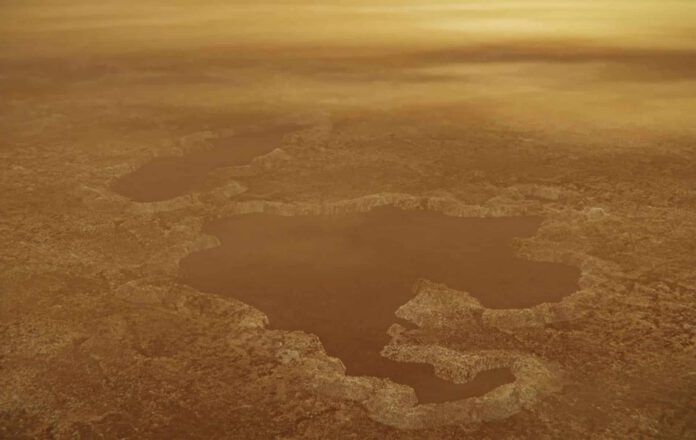
And these are probably strong enough to erode the shores and coastlines.
Fascinating Moon
Titan is undoubtedly one of Saturn’s most fascinating moons. This is primarily because the moon, like Earth, has stable liquids on its surface. Titan is even the only other celestial body in our solar system where currently active rivers, lakes, and seas exist. After a closer look at these waters, researchers have now discovered something very special.
Liquids
The hydrological cycle on Titan functions similarly to that on Earth, with one major difference: instead of water, the lakes and seas on Titan contain methane and ethane. On Earth, these hydrocarbons mainly exist as gases. However, Titan is so cold that these substances behave as liquids on the moon. The rivers are therefore thought to be filled with liquid methane and ethane, which flow into large lakes and seas, some comparable in size to those on Earth. In 2007, the existence of these waters on Titan was confirmed by images from NASA’s Cassini spacecraft. Since then, scientists have intensively studied these and other images to better understand the mysterious, liquid world.
Waves
Geologists from MIT have recently examined Titan’s shores and coastlines closely. Using simulations, they have now demonstrated that the moon’s large lakes and seas are very likely to have waves. This is a remarkable finding, implying that an avid surfer could enjoy themselves on Titan.
Controversial Topic
It’s not the first time researchers have suggested that waves exist in Titan’s surface waters. Earlier, scientists observed indirect and sometimes confusing signals of wave activity in the images. The presence of waves on Titan has thus been a somewhat controversial topic since Cassini discovered liquids on its surface. “Some observers looking for evidence of waves saw nothing and concluded that the waters were mirror-smooth,” says lead researcher Rose Palermo. “Others noted some roughness on the liquid surface but doubted if it was caused by waves.”
Different Approach
To uncover the truth once and for all, the researchers tried a different approach this time. “Instead of directly searching for wave-like features in Titan’s images, we chose another method,” explains researcher Taylor Perron. “By merely looking at the shape of the shores and coastlines, we aimed to determine what caused the erosion.”
Erosion
They started by modeling the erosion processes as they occur on Earth. Then, they applied their models to Titan’s waters to find out which erosion process best explained the shorelines seen in the Cassini images. The researchers considered three possible scenarios for what might have happened: no coastal erosion, erosion caused by waves, and ‘uniform erosion,’ where liquid passively dissolves the coastal material or the coast gradually crumbles under its own weight. “We found that uniform erosion results in a very different final shape compared to erosion by waves,” says Perron. “The flooded river valleys all look a bit like the flying spaghetti monster, but the two types of erosion lead to very different end results.”
Shorelines
After further analysis, the researchers reached a clear conclusion: the shorelines have most likely been eroded by waves. “From our results, we can conclude that if the shores and coastlines of Titan’s lakes and seas were indeed eroded, waves were most likely the main factor,” states Perron. “Suppose we were standing on the edge of a sea on Titan, we might see waves of liquid methane and ethane crashing against the coast. These waves would be capable of eroding the material that makes up the shoreline.”
Significance
Why is it important to determine whether there are waves on Titan? This could provide scientists with insight into the moon’s climate, such as the strength of the winds that can generate waves. This information could also help predict how the shape of Titan’s seas might develop over time. The researchers are now trying to determine how strong the winds on Titan must be to generate waves that can continually erode the shores. They are also trying to figure out from which directions the wind predominantly blows, based on the shape of Titan’s shorelines and coastlines.
The researchers emphasize that their findings are not definitive. To confirm the presence of waves on Titan, direct observations of wave activity on the moon’s surface are necessary. But if the team is correct, this could have significant implications. “Titan offers a unique example of a completely pristine system,” Palermo notes. “Studying it can provide us with fundamental insights into how shorelines erode without human influence. This knowledge could potentially help us better manage our own shores and coastlines on Earth in the future.”











